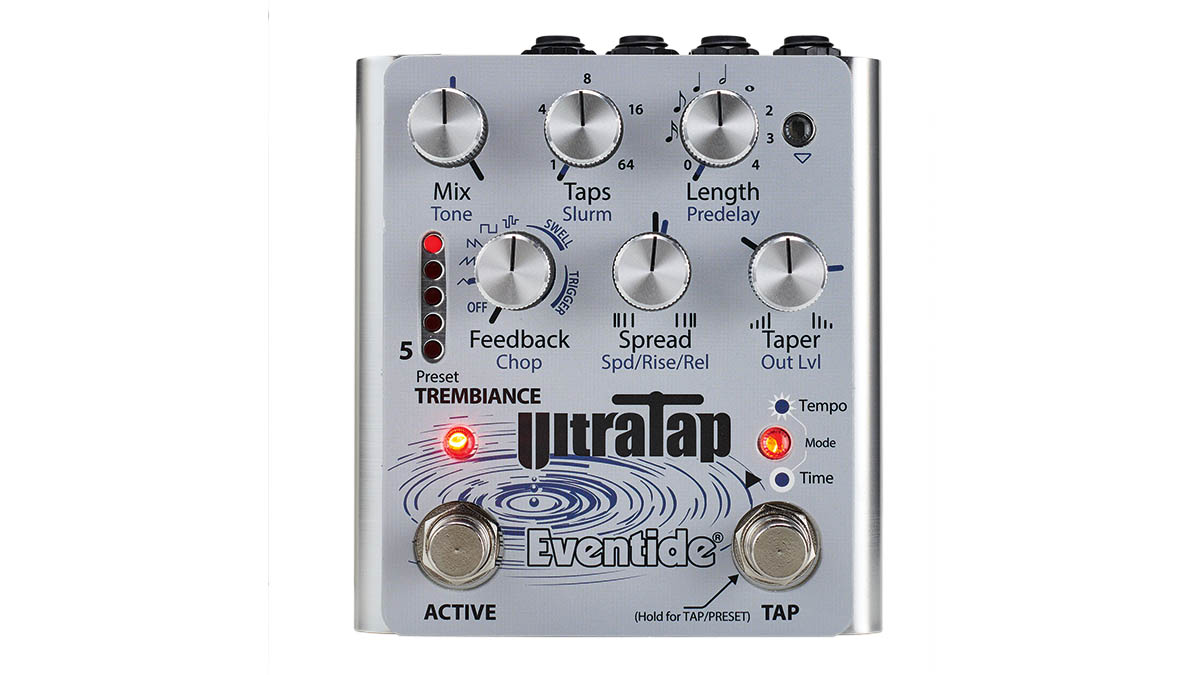Guitar World Verdict
With a host of conventional – and absolutely not conventional – sounds to explore, this is one of the most impressive delay pedals you can get your hands on. Highly recommended.
Pros
- +
Huge range of delay-based effects.
- +
Tap tempo.
- +
Mono or stereo operation.
- +
Expression pedal input.
Cons
- -
Nothing.
You can trust Guitar World
We’ve taken a look at a couple of Eventide pedals that offer a dedicated version of the company’s signature effects. Now it’s the turn of the UltraTap, which follows the MicroPitch.
This series has now been given a name – the dot9 – presumably as they can be found all together in the Eventide H9 pedal. However, the roots of the UltraTap go back 40 years to Eventide’s Digiplex and MultiTap Delay algorithms for the SP2016 Effects Processor.
The effect – a multi-tap delay based on the idea of a multi-head tape echo – evolved to be a staple of the rackmount H3000 and can be currently found as a plug-in, as well as in the H9 and this new pedal, which the company says further builds on the effect. The UltraTap lets you add as many virtual tape heads as you want alongside the ability to expressively control head position and output level.
The pedal supports 127 presets, five accessed from holding down the Tap footswitch and the rest available via MIDI or directly loaded via a USB connection to the computer-based Eventide Device Manager (EDM) software. Input can be mono or stereo and you can have a mono output or use both outputs for panned taps.

In Use
The UltraTap has the same double footswitch configuration as previous dot9 pedals and has six knobs controlling a dozen parameters, the six secondary parameters being accessed by pressing a small toggle button.
The basic delay sound is set by choosing the number of taps (up to 64) and then using the Length knob for the total time over which they are spaced (up to four seconds). Typically, setting three taps over, say, a length of 400ms would give you a starting point like a tape echo with three heads.
In the middle of the pedal, a Spread knob has a central position where the taps are evenly spaced, but it can spread them out so that either earlier or later taps are bunched together. We found this useful to help emulate some of the head spacings found on vintage tape echoes.
All the latest guitar news, interviews, lessons, reviews, deals and more, direct to your inbox!

Feedback and Mix knobs do what you’d expect, but then you have a Taper knob, with a central position offering taps at an equal level, which you can adjust so the taps get progressively louder or progressively quieter.
Moving on to the secondary parameters, there’s a very useful Tone knob to make your taps darker or brighter, and the delightfully named Slurm knob that slurs and smears the tap sound – very useful for washes of reverb and diffuse delays.
You can also add up to one second of pre-delay before the first tap, which offers practical options for separation of your guitar sound from any dense cloud of ambience you might dial in, and there are a couple of knobs that work together to modulate the taps based on LFO shapes or the envelope of the audio. These can chop the sound source into glitchy stuttered rhythms or even provide a straight tremolo effect if you keep the delay time at zero.

Sounds
With all of those controls, there’s a heck of a lot you can do with this pedal, which is demonstrated in the 46 factory presets that Eventide has put into the EDM for you to try out. It’s a good starting point for your own creations: while the knobs offer quite fine adjustments, using the EDM lets you get precise.
You can have all the simple repeats you’d find in any digital delay pedal – a single tap with feedback gives you the basics – but that’s just scratching the surface because what you have here is a comprehensive resource for creating a variety of rhythmic delays, atmospheric ambiences, swells and modulations.
For performance, the main footswitch can be latching or momentary, there’s tap tempo, and an expression pedal can be assigned to adjust multiple parameters. The two footswitches work together to access five onboard presets for a reasonable arsenal of sounds on stage, but there are also options to employ external footswitches or use MIDI control, which will give you access to 127 presets. Phew!
Specs
- PRICE: $/£279
- ORIGIN: China
- TYPE: Multi-tap delay pedal
- FEATURES: Multiple Bypass options (Buffered, Relay, DSP+FX or Kill dry), tap tempo, latching or momentary footswitch action, 5 onboard presets, will take line level as well as guitar
- CONTROLS: Mix/Tone, Taps/Slurm, Length/Predelay, Feedback/Chop, Spread/Spd/Rise/rel, Taper/Output Level, Shift button, Mono/Stereo switch, Guitar/Line level switch, Active footswitch, Tap footswitch
- CONNECTIONS: Standard input, standard outputs 1 & 2, EXP, USB
- POWER: Supplied 9V DC adaptor 200ma
- DIMENSIONS: 100 (w) x 115 (d) x 58 mm (h)
- CONTACT: Eventide Audio
Trevor Curwen has played guitar for several decades – he's also mimed it on the UK's Top of the Pops. Much of his working life, though, has been spent behind the mixing desk, during which time he has built up a solid collection of the guitars, amps and pedals needed to cover just about any studio session. He writes pedal reviews for Guitarist and has contributed to Total Guitar, MusicRadar and Future Music among others.


